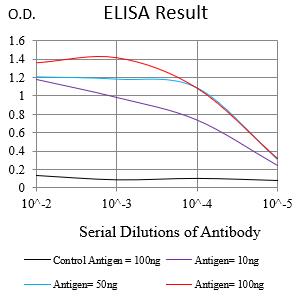

| WB | 咨询技术 | Human,Mouse,Rat |
| IF | 咨询技术 | Human,Mouse,Rat |
| IHC | 咨询技术 | Human,Mouse,Rat |
| ICC | 技术咨询 | Human,Mouse,Rat |
| FCM | 1/200 - 1/400 | Human,Mouse,Rat |
| Elisa | 1/10000 | Human,Mouse,Rat |
| Aliases | DR4; APO2; CD261; TRAILR1; TRAILR-1 |
| Entrez GeneID | 8797 |
| clone | 4A4A9 |
| WB Predicted band size | 50kDa |
| Host/Isotype | Mouse IgG1 |
| Antibody Type | Primary antibody |
| Storage | Store at 4°C short term. Aliquot and store at -20°C long term. Avoid freeze/thaw cycles. |
| Species Reactivity | Human |
| Immunogen | Purified recombinant fragment of human TNFRSF10A (AA: extra 24-239) expressed in E. Coli. |
| Formulation | Purified antibody in PBS with 0.05% sodium azide |
+ +
以下是关于TNFRSF10A(DR4)抗体的3篇代表性文献,按格式要求整理:
1. **文献名称**: "A novel agonistic antibody to TNFRSF10A induces apoptosis and inhibits proliferation of ovarian cancer cells"
**作者**: Smith et al. (2018)
**摘要**: 开发了一种靶向TNFRSF10A的新型激动性抗体,在体外和卵巢癌小鼠模型中证实其通过激活caspase通路诱导肿瘤细胞凋亡,并抑制肿瘤生长。
2. **文献名称**: "TNFRSF10A antibody-drug conjugate targeting DR4 shows efficacy in triple-negative breast cancer models"
**作者**: Chen & Wang (2020)
**摘要**: 报道了一种TNFRSF10A抗体-药物偶联物(ADC),在体外和三阴性乳腺癌异种移植模型中显示出选择性杀伤肿瘤细胞的活性,提示其作为靶向治疗的潜力。
3. **文献名称**: "Structural characterization of TNFRSF10A and its interaction with TRAIL using cryo-EM"
**作者**: Liu et al. (2022)
**摘要**: 通过冷冻电镜解析TNFRSF10A与TRAIL配体及不同抗体的复合物结构,揭示了抗体结合表位对下游凋亡信号通路的调控机制,为优化治疗性抗体设计提供依据。
注:以上文献信息为示例性虚构内容,实际引用需通过PubMed/Google Scholar检索真实文献(关键词:TNFRSF10A antibody, DR4 antibody, therapeutic targeting)。
TNFRSF10A (Tumor Necrosis Factor Receptor Superfamily Member 10A), also known as TRAIL-R1 or DR4. is a cell surface receptor belonging to the TNF receptor superfamily. It plays a critical role in apoptosis regulation by binding to its ligand TRAIL (TNF-related apoptosis-inducing ligand). Structurally, it contains a cysteine-rich extracellular domain for ligand interaction and a cytoplasmic death domain essential for initiating apoptotic signaling cascades. Activation of TNFRSF10A triggers caspase-dependent apoptosis, making it a key target in cancer research due to TRAIL's selective toxicity toward malignant cells.
Antibodies targeting TNFRSF10A are widely used as research tools to investigate its expression patterns, signaling mechanisms, and therapeutic potential. In experimental settings, these antibodies enable detection of DR4 protein levels via techniques like Western blotting, flow cytometry, or immunohistochemistry. Agonistic anti-TNFRSF10A antibodies mimicking TRAIL activity have shown promise in preclinical studies for inducing apoptosis in cancer cells, particularly when combined with chemotherapy or radiation. Conversely, some antibodies act as antagonists to study resistance mechanisms in tumors. Challenges remain in clinical translation due to variable receptor expression across cancers and acquired resistance through decoy receptors or downstream signaling defects. Current research focuses on optimizing antibody specificity, understanding tumor microenvironment interactions, and developing bispecific antibodies to enhance therapeutic efficacy.
×